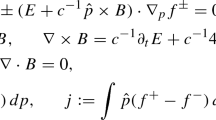Abstract
One of us [1] has considered the equations of the quasi-linear approximation for a plasma with collisions, which, for a spatially homogeneous plasma without a magnetic field in the stationary case, are as follows:
in which ε(ω, k) is the dielectric constant of the plasma for longitudinal waves (k‖E), fa(P) is the distribution function for particles of type a, Sa is the collision integral (which is put in the Landau form for a Coulomb plasma without allowance for polarization), and va is the reciprocal relaxation time due to collisions in the rapidly varying (pulsating) part of the distribution function. In general, va is a function of velocity, and it can be expressed via the distribution function for the background under the conditions for which the equations of the quasi-linear approximation were derived. The va for a slightly nonequilibrium plasma may be considered as some effective collisional frequency averaged over the momenta, which for the electrons makes a certain contribution to the imaginary part of the dielectric constant, where va can be calculated [2, 3] if fa is known.
An important point is that Eqs. (0.1) were derived for a monochromatic longitudinal wave, and so it is not a necessary condition to have a sufficiently large width for the wave packet, which condition is characteristic of the quasi-linear theory previously given. However, as in the quasi-linear theory, it is assumed that the oscillation amplitude is small (so that nonlinear interaction between waves can be neglected), and so
while the dimensionless parameter ea2¦E¦2/maTava 2 may be on the order of, or even much greater than, unity.
In §1 of this paper we use the equations for the energy and momentum to derive expressions for the electron drift velocity and the difference Te−Ti (electron and ion temperatures) for a two-component plasma in a given wave field on the assumption of Maxwellian background distribution functions for the electrons and ions. Expression (1.14) for the temperature difference extends to longitudinal waves a result obtained in [4] on the heating of electrons in a strong electric field.
Section 2 deals with the amplitudes of steady-state high-frequency Langmuir waves when the plasma contains a steady electron beam. We derive in §3 the steady-state electron distribution function for the one-dimensional case on the basis of a model collision integral, and this differs only slightly from the Maxwellian case in which the spatial dispersion Is slight.
Similar content being viewed by others
References
Yu. L. Klimontovich, Statistical Theory of Nonequilibrium Plasma Processes [in Russian], Izd. MGU, 1964 (see also the supplement to the English edition).
V. P. Silin, “High-frequency dielectric constant of a plasma,” ZhETF, 41, 861, 1961.
V. V. Loginov, “Relaxation in a Coulomb quasiequilibrium plasma,” Vestnik Mosk. un-ta., no. 1, 1967.
V. L. Ginzburg and A. V. Gurevich, “Nonlinear phenomena in a plasma in an alternating electromagnetic field,” Usp. fiz. nauk,70, no. 2, 1960.
D. V. Sivukhin, “Coulomb collisions in a completely ionized plasma,” collection: Plasma Theory, No. 4 [in Russian], Atomizdat, 1964.
Ya. B. Fainberg and V. D. Shapiro, “Quasilinear theory of wave excitation in the injection of an electron beam into a plasma half-space,” ZhETF, 47, 1389, 1964.
V. L. Ginzburg, Propagation of Electromagnetic Waves in a Plasma [in Russian], Fizmatgiz, 1960.
Author information
Authors and Affiliations
Rights and permissions
About this article
Cite this article
Klimontovich, Y.L., Logvinov, V.V. Stationary solutions to the equations of the quasi-linear approximation for a plasma with collisions. J Appl Mech Tech Phys 8, 20–23 (1967). https://doi.org/10.1007/BF00918025
Issue Date:
DOI: https://doi.org/10.1007/BF00918025



